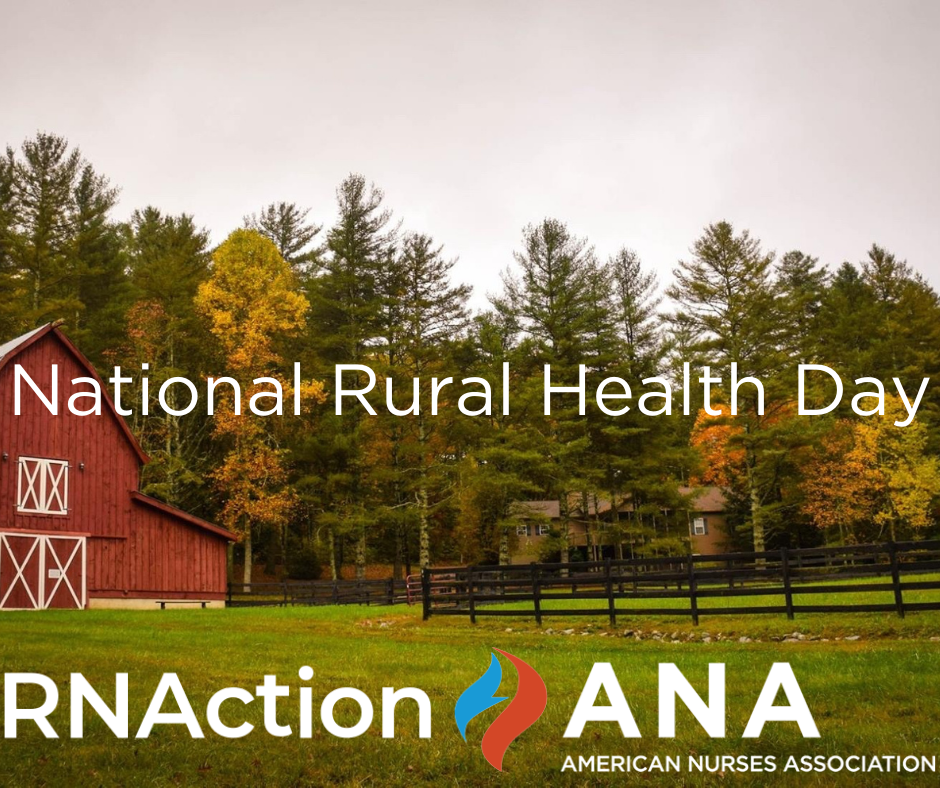
Today, November 19, we celebrate National Rural Health Day and acknowledge the nurses that are critical to ensuring access to health care services in rural communities across the nation. This year we focus on rural health and the role you play as clinicians in rural communities, in the midst of the ongoing COVID-19 pandemic, at a time where the number of cases and hospitalizations are steadily increasing. As we begin the holiday season, the Centers for Disease Control and Infection (CDC) continues to issue guidance and recommendations for mitigation efforts necessary to curb the spread of the virus.
ANA continues to recognize and advocate on behalf of all nurses on the frontlines of the pandemic response, as well as providing resources and support. The association knows the role of the nurse is especially critical in our rural communities that struggle with continued or exacerbated spread of the virus. This is particularly concerning as the CDC has detailed how people living in rural areas are at higher risk of contracting and/or facing complications from COVID-19. Because of this increased risk, the CDC has provided several resources and information for rural communities to respond to the COVID-19 pandemic.
In addition to releasing rural-focused data and resources, CDC also recently released data detailing how pregnant women face an increased risk of severe illness if they contract the virus, as well. The agency is working with state and external partners to collect information on COVID-19 cases in pregnant women and it continues to monitor the impact. The increased risk of COVID-19 to pregnant women is troubling given the underlying issue of existing high rates of maternal mortality in the United States, with rates more likely to be greater in rural areas.
Just earlier this year, we saw the Centers for Medicare & Medicaid Services (CMS) issue a Request for Information (RFI) seeking comment from stakeholders on how to improve access to care and outcomes for women and infants in rural communities. Submissions to the RFI, part of CMS’ larger goal of improving health through the Rethinking Rural Health Initiative, will inform the agency as it develops new and refines existing programs targeting rural families. ANA used this opportunity to share with CMS how nurses in rural communities are an integral part in addressing maternal health and ensuring women have access to needed health care services before, during, and after their pregnancy.
ANA recognizes existing barriers to improving maternal health in rural areas, such as gaps in access to providers or loss of coverage. To mitigate these barriers and challenges, nurses must be engaged to expand provider capacity. This includes utilizing Certified Nurse Midwives (CNMs) for pregnancy care, Nurse Practitioners (NPs) trained in women’s health, and Registered Nurses (RNs) to providing care coordination and connecting women to needed services—all leading to better outcomes for women and infants. Across the country, nurses are leading maternity and infant care models that ensure access to care, provide quality care, and ensure better outcomes.
Innovative models and initiatives must be encouraged in strategies to address maternal health in rural areas. It is imperative that strategies strengthen and uplift the contributions of nurses in all communities. Nurses are an integral part in the health care delivery system—especially in rural communities that face barriers to accessing needed care. Innovative payment models should be developed and implemented that recognize the critical value of RNs, NPs, and CNMs and adequately compensate for services these clinicians provide. To address gaps in access to providers, states must be incentivized to allow NPs and CNMs to practice at the full extent of their education and training.
We expect to see renewed attention on discussing and addressing maternal mortality and morbidity at the federal level. For example, the Medicaid and CHIP Payment and Access Commission continues to discuss this issue at public meetings and the June 2020 Report to Congress includes a chapter examining why mortality and morbidity rates continue to rise. As policymakers seek approaches to address rural maternal health challenges and barriers, the critical role of the nurse cannot be overstated. Leveraging the education and expertise of CNMs, NPs, and RNs to expand provider capacity and lead innovative care delivery models will only result in better maternal and infant health.
ANA continues to closely monitor this issue and take advantage of opportunities to highlight the importance of the nurse in addressing maternal health and other health care challenges in rural communities. In addition to the resources linked above, the following are available to better understand current challenges in addressing rural maternal health:
• Maternal Health Care in Rural Communities
• Maternal and Obstetric Care Challenges in Rural America
• Rural Disparities, Racial Disparities, and Maternal Health Crisis Call Out for Solutions
• Left Out: Barriers to Health Equity for Rural and Underserved Communities
We want to hear from you! Share your story of #RNAction in rural health by sending a message to rnaction@ana.org.

